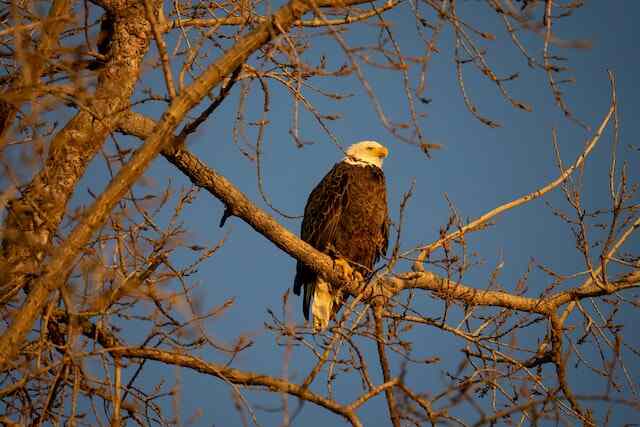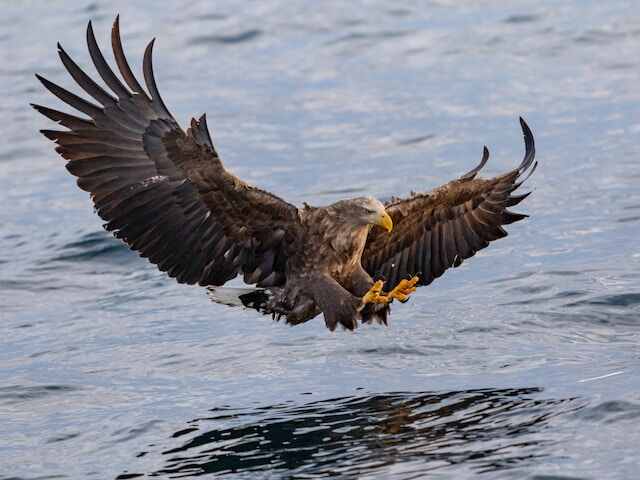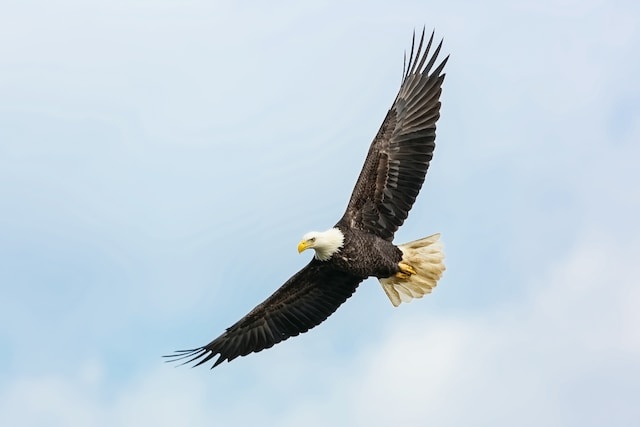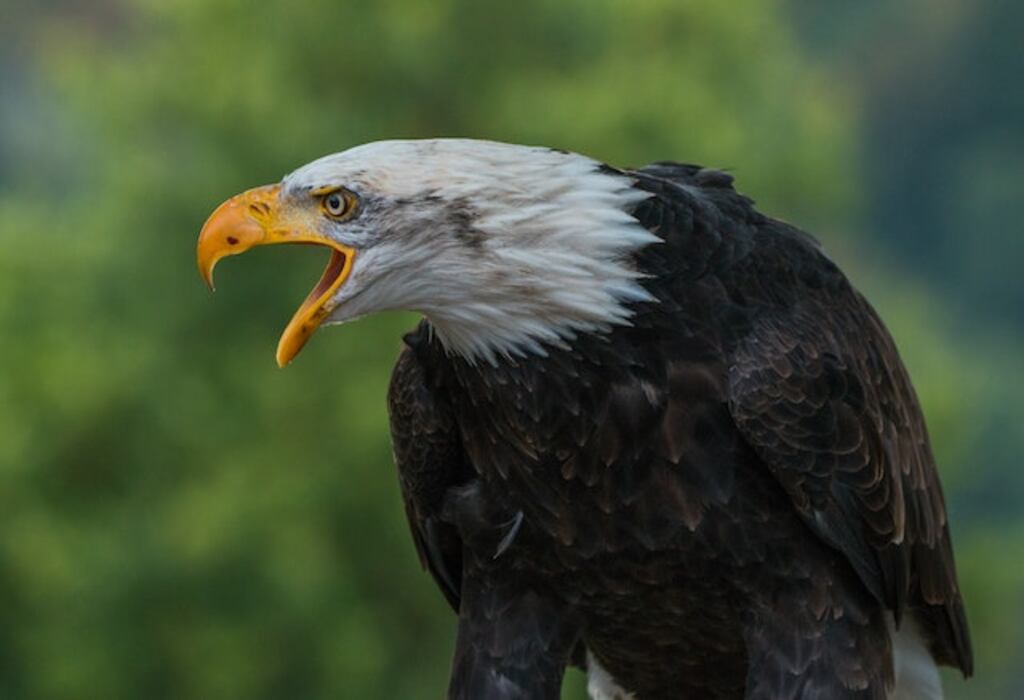How Do Eagles Kill Their Prey? Eagles, the majestic birds of prey, embody strength, freedom, and power. With sharp talons, an impressive wingspan, and a piercing gaze, they’ve captivated us for centuries.
Today, we embark on an exhilarating journey to demystify how these enigmatic hunters unleash their might.
Discover the intricacies of their anatomy, the brilliance of their behavior, and the awe-inspiring strategies they employ to maintain the delicate balance of ecosystems.
Brace yourself as we unravel the mystery behind how eagles conquer their prey, shedding light on the captivating secrets of nature’s most efficient predators.
Table of Contents
- 1 Key Takeaways
- 2 Overview of Eagles as Apex Predators
- 3 How Do Eagles Kill Their Prey
- 4 Hunting Techniques of Eagles
- 5 The Role of Eagles in the Ecosystem
- 6 The Anatomy of Eagles
- 7 How Eagles Use Their Talons to Capture Prey
- 8 How Eagles Use Their Beaks to Kill Prey
- 9 How Eagles Use Their Wings to Hunt
- 10 Examples of Prey Eagles Hunt
- 11 Hunting Strategies for Different Types of Prey
- 12 Conservation Efforts for Eagles
- 13 Frequently Asked Questions
- 14 Conclusion
- 15 Author
Key Takeaways
- Eagles use various techniques to capture prey, including ambush hunting, pursuit hunting, fishing, and scavenging.
- Eagles have anatomy perfectly adapted for flight and hunting, with wings, eyesight, and talons being key features.
- Eagles employ a variety of hunting strategies depending on prey size, mobility, and behavior.
- Eagles play a crucial role in maintaining the ecological balance of their habitat and are impacted by human activities such as habitat loss and hunting.

Overview of Eagles as Apex Predators
Eagles are recognized as apex predators due to their exceptional hunting skills, large size, and powerful talons.
They are one of the most impressive birds of prey, with a keen sense of sight, hearing, and smell, and are able to fly at great heights and speeds.
Eagle behavior is also significant to the ecosystem, as they help to control populations of smaller animals and maintain balance in their respective habitats.
As apex predators, eagles play an important role in maintaining a healthy ecosystem.
In the next section, we will explore the hunting techniques of eagles.
How Do Eagles Kill Their Prey
Eagles kill their prey using various techniques. They employ ambush hunting, pursuing targets in swift dives or engaging in intense aerial pursuits.
With their powerful talons and sharp beaks, they deliver deadly strikes to immobilize and kill prey. Eagles are also skilled fishers and opportunistic scavengers.
Their hunting methods showcase their adaptability and effectiveness as apex predators in maintaining ecosystem balance.

Hunting Techniques of Eagles
Eagles are skilled hunters that employ various techniques to capture their prey.
Ambush hunting involves waiting patiently for the prey to come within striking range, while pursuit hunting requires the eagle to actively chase and capture its prey.
Fishing involves swooping down onto the water and snatching fish with their talons, while scavenging involves feeding on the remains of already dead animals.
These hunting techniques demonstrate the versatility and adaptability of eagles in their pursuit of food.
Ambush Hunting
With a keen sense of sight and patience, some raptor species like eagles employ an ambush hunting strategy to catch their prey. This involves waiting for their target to come within range before launching a surprise attack.
Eagles are known to use camouflage tactics to blend in with their surroundings, making it easier for them to go unnoticed by their prey.
Once they spot their target, eagles use their powerful talons to grab onto their prey and deliver a deadly blow.
This hunting technique has proven to be very successful for eagles, as they are known to have a high hunting success rate.
For those who desire freedom, watching an eagle execute an ambush attack is a thrilling sight to behold.
As we move on to the next section on pursuit hunting, it is important to note that eagles have mastered the art of both ambush and pursuit hunting, making them formidable predators in the animal kingdom.
Pursuit Hunting
Pursuit hunting is a method of hunting used by many predators that involves actively chasing and catching prey, often requiring a combination of speed and endurance.
Eagles are known to use pursuit hunting to catch their prey, which can be done either solo or in a group.
When hunting solo, eagles typically use their exceptional eyesight to spot potential prey from a distance and then use their powerful wings to take off and pursue the prey in a high-speed dive.
During this dive, eagles can reach speeds of up to 200 miles per hour, making them one of the fastest birds in the world.
Group hunting, on the other hand, involves several eagles working together to corner and capture larger prey, such as deer or antelope.
In this strategy, one eagle will initiate the pursuit, while the others will follow in pursuit, taking turns to attack the prey until it is brought down.
Pursuit hunting is a highly effective method for eagles to catch their prey, as it allows them to use their speed, agility, and coordination to outmaneuver their prey.
Next, we will explore how eagles use their hunting skills to catch fish.
Fishing
Despite their sharp talons and powerful beaks, hunting for fish can be a challenging task for many predatory birds, including eagles.
However, eagles have developed various fishing techniques that allow them to successfully catch fish, one of their preferred prey. These techniques include:
- Perching on a high vantage point above water bodies to spot fish swimming near the surface.
- Gliding low over the water with their talons extended to snatch fish from the surface.
- Diving from a great height to catch fish in their talons with incredible speed and precision.
- Using their powerful wings to create a wave that will force fish to the surface, making them easy targets for the eagle’s talons.
Eagles may also choose to scavenge for fish that have already died or are injured, instead of actively hunting them.
Overall, eagles have developed various impressive techniques to hunt and catch fish, one of their favorite prey.
In the subsequent section about scavenging, we will explore how eagles also use this as a way to obtain food.
Scavenging
Scavenging for food is a common behavior observed in many bird species, including eagles. Eagles are opportunistic feeders and will consume a variety of prey items, including carrion.
In fact, eagles are often seen competing with other scavengers, such as vultures, for access to carrion. Scavenging dynamics can be complex, with multiple species vying for the same food source.
Despite this competition, eagles are efficient scavengers and are able to consume a significant amount of carrion.
The consumption of carrion is an important aspect of the eagle’s diet and plays a role in the ecosystem by removing dead animals from the environment.

As such, eagles are an important part of the natural balance of their habitat.
The Role of Eagles in the Ecosystem
Eagles play a crucial role in maintaining the ecological balance of their habitat by regulating the population of their prey and providing a source of food for other organisms.
With their sharp vision, powerful talons, and strong beaks, they are able to hunt and kill a variety of prey, such as fish, small mammals, and birds.
As top predators, they help to control the population of their prey, preventing overgrazing and maintaining a healthy ecosystem.
In addition, eagles provide a source of food for other organisms, such as scavengers and decomposers, which helps to recycle nutrients back into the ecosystem.
Despite their importance, eagles have been impacted by human activities, such as habitat loss and hunting, leading to declines in their populations.
Conservation efforts, such as habitat protection and reintroduction programs, have helped to stabilize populations and ensure the continued role of eagles in the ecosystem.
Understanding the anatomy of eagles, including their keen eyesight and powerful flight muscles, can provide insight into their hunting behaviors and help inform conservation efforts to protect these majestic birds.
The Anatomy of Eagles
With their wingspan reaching up to 7 feet, eagles are known for their impressive size and physical strength.
Their anatomy is perfectly adapted for flight, with their powerful wings allowing them to soar high in the sky with ease.
Additionally, eagles have remarkable visual acuity, with their eyesight being up to 4 times better than that of a human. This allows them to spot their prey from great distances and accurately target their attacks.
Furthermore, the structure of their talons is specifically designed for capturing and grasping their prey, with sharp, curved talons that can exert immense pressure and puncture through even the toughest of hides.
In the next section, we will explore how eagles use these talons to effectively capture their prey.
How Eagles Use Their Talons to Capture Prey
The anatomy of eagles is specifically designed for hunting and capturing prey. Their talons are formidable weapons, and the science behind them is fascinating.
With a grip strength that can exert hundreds of pounds of pressure per square inch, eagles are able to capture prey much larger than themselves.
The talons are curved and sharp, with a hook on the end that allows eagles to latch onto their prey and hold on tight.
The talon anatomy also includes a locking mechanism that keeps the talons in place once they’ve penetrated the prey.
It’s truly remarkable how eagles use their talons to capture prey, and it’s a testament to the incredible adaptations of these birds of prey. Next, we will explore how eagles use their beaks to kill prey.

How Eagles Use Their Beaks to Kill Prey
The beak of an eagle is an incredibly powerful tool, capable of exerting pressures of up to 400 pounds per square inch. This is due to the beak’s unique anatomy, which consists of a sharp, hooked tip, and a strong, muscular base.
Eagles use their beaks to grasp and hold onto prey, as well as to tear apart flesh and crush bones. To kill their prey, eagles use their beaks in a variety of ways.
First, they may bite down on the animal’s neck or head to sever the spinal cord or crush the skull.
Alternatively, they may use their beak to suffocate the prey by covering its mouth and nose. Finally, eagles may use their beak to pierce and damage vital organs, such as the heart or lungs.
All of these methods of prey manipulation require incredible precision and strength, both of which are inherent in the eagle’s beak anatomy.
As we move on to the next section about how eagles use their wings to hunt, it is important to note that the eagle’s beak is just one of the many tools in its arsenal for successful hunting.
How Eagles Use Their Wings to Hunt
Utilizing their wings as a tool for hunting, eagles glide through the air with an effortless grace, surveying the terrain below for potential prey.
The wing structure of eagles is perfectly adapted for efficient and effective hunting.
Eagles have long, broad wings that allow them to soar effortlessly for extended periods of time, and their powerful muscles enable them to maneuver quickly and precisely.
When hunting, eagles use their wings to control their speed and direction, allowing them to quickly dive towards their prey with incredible force and accuracy.
Their hunting behavior is a sight to behold, as they use their wings to gain altitude before diving at speeds of up to 200 miles per hour to catch their prey.
With such impressive hunting techniques, eagles are able to catch a wide variety of prey, from small rodents to large mammals and fish.
As we delve into examples of prey eagles hunt, we will see just how versatile and skilled these magnificent birds truly are.
Examples of Prey Eagles Hunt
In addition to using their wings to hunt, eagles have also developed hunting adaptations that allow them to capture a variety of prey species.
Some common prey species that eagles hunt include fish, small mammals, and birds. To capture fish, eagles will swoop down and grab them with their talons, often submerging themselves underwater in the process.
When hunting small mammals and birds, eagles will use their sharp talons and strong beaks to quickly dispatch their prey.
These hunting adaptations allow eagles to successfully hunt a wide range of prey species, making them one of the most successful predators in the animal kingdom.
Moving forward, we will explore the different hunting strategies that eagles employ when hunting different types of prey.

Hunting Strategies for Different Types of Prey
When hunting different types of prey, eagles employ a variety of strategies to capture their targets. Predator-prey dynamics play a significant role in determining an eagle’s hunting method.
Adaptations for hunting include keen eyesight, sharp talons, and powerful wings that allow eagles to swoop down at high speeds on unsuspecting prey.
The hunting strategies vary depending on the prey’s size, mobility, and behavior.
For smaller prey like rodents and rabbits, eagles may hover in the air until they spot their target and then swoop down to catch it with their talons.
For larger prey like deer or goats, eagles will often stalk their prey from above and then dive at high speeds to knock it off balance before grabbing it with their talons.
When hunting fish, eagles will fly low over water bodies and use their sharp talons to grab fish swimming near the surface.
Overall, eagles’ unique hunting strategies and adaptations make them successful predators in various ecosystems.
As conservation efforts continue to protect these majestic birds, it is essential to understand their hunting behavior to ensure their survival in the wild.
Conservation Efforts for Eagles
Efforts to conserve eagle populations have become increasingly important in recent years, as these birds of prey play a crucial role in maintaining the balance of various ecosystems, proving the adage that every species has its place in the natural world.
One of the conservation efforts that have been implemented is the establishment of breeding programs, which aim to increase the eagle population and ensure their genetic diversity.
These programs involve the breeding of eagles in captivity and the release of their offspring into the wild.
Another conservation effort is habitat restoration, which involves the restoration of eagle habitats that have been destroyed or degraded due to human activities such as logging and mining.
This effort aims to provide eagles with suitable habitats where they can thrive and reproduce.
These conservation efforts are crucial in ensuring the survival of eagle populations and maintaining the ecological balance of their habitats.

Frequently Asked Questions
What is the average lifespan of an eagle?
The average lifespan of eagles varies by species, ranging from 15 to 30 years in the wild. Eagle habitats and diets differ as well, with some preferring fish while others hunt small mammals. Their freedom to soar through the skies is a defining characteristic of eagles.
How do eagles mate and reproduce?
Eagles mate for life and perform elaborate courtship rituals before nesting. They build large nests high up in trees or on cliffs, with some species returning to the same nest year after year.
How do eagles communicate with each other?
Eagles communicate through vocalizations and body language to establish social hierarchy and coordinate hunting tactics. Their behaviors are technically sophisticated and engaging for those with a subconscious desire for freedom.
What are the different species of eagles, and how do they differ from each other?
Eagle species diversity is vast, with over 60 recognized species. They differ in size, habitat, and hunting techniques. For example, the bald eagle is a fish hunter, while the golden eagle preys on mammals.
How do eagles adapt to different habitats and environments?
Eagles adapt to different habitats and environments through their nesting habits and hunting techniques. They build nests in high places and use their keen eyesight, powerful talons, and strong beaks to hunt prey, allowing them the freedom to thrive in a variety of landscapes.

Conclusion
Eagles are apex predators that play a crucial role in maintaining the balance of the ecosystem. They have developed unique hunting techniques and specialized anatomy that allows them to capture a wide range of prey.
Their talons are their main weapon, and they use their wings to control their movements during the hunt.
Eagles hunt various prey, including fish, small mammals, and birds.
They have different strategies for hunting each type of prey, such as using their speed and agility to catch birds in mid-air and their strength to carry away larger prey such as deer.
However, as human activity continues to encroach on their habitats, eagles face numerous threats, including habitat loss and hunting.
Conservation efforts must be made to ensure the survival of these magnificent birds.
In conclusion, eagles are remarkable apex predators with unique hunting techniques and specialized anatomy that enable them to capture a wide range of prey.
Their crucial role in the ecosystem cannot be overstated, and their conservation is of utmost importance.
As the saying goes, ‘A bird in the hand is worth two in the bush,’and we must work to preserve these magnificent birds for future generations.


